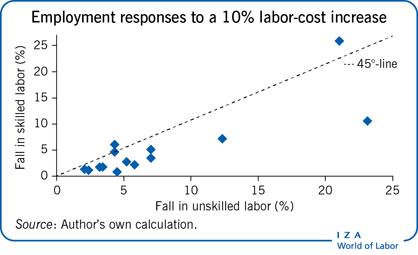Elevator pitch
Higher labor costs (higher wage rates and employee benefits) make workers better off, but they can reduce companies’ profits, the number of jobs, and the hours each person works. The minimum wage, overtime pay, payroll taxes, and hiring subsidies are just a few of the policies that affect labor costs. Policies that increase labor costs can substantially affect both employment and hours, in individual companies as well as in the overall economy.

Key findings
Pros
Cutting labor costs induces companies to employ more workers.
Increasing the minimum wage that employers must pay their workers prevents employers from exploiting workers who have few alternatives.
Increasing the minimum wage that employers must pay their workers increases earnings among low-wage workers who retain their jobs.
Increasing the penalty that employers pay for overtime work prevents employers from imposing long hours on individual employees.
Increasing the penalty that employers pay for overtime work may encourage new job creation that can reduce unemployment.
Cons
Any cut in the supply of labor to a market will raise wages—and raise employers’ costs.
Increasing the minimum wage that employers must pay reduces total hours worked—total jobs times hours per job—but with small impacts if minimum wage levels are low compared to average wages.
Increasing the minimum wage that employers must pay their workers has the biggest negative effect on the unskilled and minorities as well as young and older workers.
Increasing the penalty that employers pay for overtime work reduces total hours worked.
Increasing the penalty that employers pay for overtime work reduces GDP.